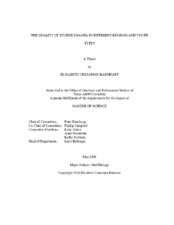The Quality of Etched Enamel in Different Regions and Tooth Types
| dc.contributor.advisor | ||
| dc.contributor.advisor | Buschang, Peter H | |
| dc.creator | ||
| dc.creator | Barnhart, Elisabeth Creasman | |
| dc.date.accessioned | 2019-10-16T20:21:27Z | |
| dc.date.accessioned | 2023-10-25T20:33:41Z | |
| dc.date.available | 2023-10-26T06:45:01Z | |
| dc.date.created | 0001-01 | |
| dc.date.created | 2019-05 | |
| dc.date.issued | 2019-03-28 | |
| dc.date.submitted | May 2019 | |
| dc.identifier.uri | https://hdl.handle.net/1969.1/184998 | |
| dc.description.abstract | en | |
| dc.description.abstract | . Purpose In vitro evaluation and quantification of etch quality in various regions and types of human teeth using novel approaches. Materials and Methods 27 extracted human teeth (3 of each tooth type) were disinfected, sectioned into mesial and distal halves, and randomly allocated to SEM or µCT for evaluations. Buccal surfaces were treated with pumice, etched with 37% phosphoric acid gel etchant for 15 seconds, rinsed, and air dried. SEM samples were dried in 100% ethanol, placed in a vacuum, and sputter coated with gold. Two regions of etched enamel in each third of the teeth (incisal, middle, and cervical) were viewed at 1200x magnification with the SEM. Using BIOQUANT Osteo (Nashville, TN) software, the percentage of enamel remaining to total surface area was calculated for each image. µCT scans were taken before and after etching. Pre- and post-etch mineral densities were calculated from the scans and compared. Results Two way analyses of variance showed no statistically significant interaction between jaw and tooth type. While there were no between-jaw differences, there were significant differences between tooth types. SEM analyses showed that premolars and molars had significantly greater remaining enamel than incisors and canines in the middle (p=.046) and cervical (p=.002) regions. Mineral densities of anterior teeth demonstrated a superior response to etching than posterior teeth. There were statistically significant regional differences, with the cervical region having greater remaining enamel than the middle (p=.015) and incisal (p=.006) regions. The cervical region was also significantly less dense than the middle (p=.004, p=.015) and incisal regions (p=.002, p=.011) at pre-etch and post-etch time points, respectively. Conclusions There are quantifiable differences in etch quality between tooth types and between regions within teeth. There is greater prismless enamel and inferior etch quality in the cervical regions, especially in premolars and molars. Response to etching is greater in anterior than posterior teeth, especially in the incisal and middle regions. Enamel density remains within accepted norms after etching with 37% phosphoric acid etchant for 15 seconds. Quantification of enamel etch quality with BIOQUANT Osteo and µCT software are valid methods of study. | en |
| dc.format.medium | electronic | en |
| dc.format.mimetype | application/pdf | |
| dc.language.iso | en | |
| dc.publisher | ||
| dc.subject | en | |
| dc.subject | en | |
| dc.subject | Enamel | en |
| dc.subject | Aprismatic | en |
| dc.subject | Mineral Density | en |
| dc.subject | Etch Pattern | en |
| dc.subject | Etch Quality | en |
| dc.title | en | |
| dc.title | The Quality of Etched Enamel in Different Regions and Tooth Types | en |
| dc.type | Thesis | en |
| thesis.degree.department | en | |
| thesis.degree.department | College of Dentistry | en |
| thesis.degree.discipline | en | |
| thesis.degree.discipline | Oral Biology | en |
| thesis.degree.grantor | en | |
| thesis.degree.grantor | Texas A & M University | en |
| thesis.degree.name | en | |
| thesis.degree.name | Master of Science | en |
| thesis.degree.level | en | |
| thesis.degree.level | Masters | en |
| dc.contributor.committeeMember | ||
| dc.contributor.committeeMember | ||
| dc.contributor.committeeMember | Campbell, Phillip M | |
| dc.contributor.committeeMember | Julien, Katie | |
| dc.contributor.committeeMember | Noureldin, Amal | |
| dc.contributor.committeeMember | Svoboda, Kathy | |
| dc.type.genre | en | |
| dc.type.material | text | en |
| dc.type.material | text | en |
| dc.format.digitalOrigin | born digital | en |
| dc.date.updated | 2019-10-16T20:21:27Z | |
| local.embargo.terms | 2021-05-01 | |
| local.etdauthor.orcid | 0000-0002-2563-1912 |
Files in this item
This item appears in the following Collection(s)
-
Electronic Theses, Dissertations, and Records of Study (2002– )
Texas A&M University Theses, Dissertations, and Records of Study (2002– )


